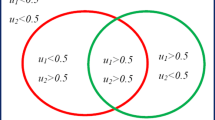Abstract
Aurora is a recurrent feature of the atmosphere, acting as a mirror of otherwise invisible coupling between different atmospheric layers. Advanced processing of auroral images has proven essential to investigate some key physical processes in near-Earth space; in particular, auroral images carry important information for research on power networks, communication systems, meteorology, and complex biological systems. Segmenting aurora images to detect auroral regions is an important step of this study. Classical image segmentation approaches fail to effectively detect auroral regions when the auroral oval is not distinct from its background in terms of pixel intensity. To reduce the negative influence of intensity inhomogeneity in auroral oval images, we design a novel active contour model which employs interval type-2 fuzzy sets for auroral oval image segmentation. The proposed method can robustly segment auroral oval images even in the presence of high intensity variations. Experimental results on Ultraviolet Imager (UVI) auroral oval images acquired from an online database including data collected by NASA Polar satellite’s UVI demonstrate the advantages of our method in terms of human visual perception and segmentation accuracy.
















Similar content being viewed by others
References
Chan TF, Vese LA (2001) Active contours without edges. IEEE Trans Image Process 10(2):266–277
Chen CL, Chen SC, Kuo YH (2014) The reduction of interval type-2 LR fuzzy sets. IEEE Trans Fuzzy Syst 22(4):840–858
Deledalle C, Denis L, Tupin F (2009) Iterative weighted maximum likelihood denoising with probabilistic patch-based weights. IEEE Trans Image Process 18(12):2661–2672
Gao XB, Fu R, Li XL, Tao DC, Zhang BC, Yang HG (2011) Aurora image segmentation by combining patch and texture thresholding. Comput Vis Image Underst 115:390–402
Geng X, Zhan DC, Zhou ZH (2005) Supervised nonlinear dimensionality reduction for visualization and classification. IEEE Trans Systems Man Cybern B 35(6):1098–1107
Gong M, Zhou Z, Ma J (2012) Change detection in synthetic aperture radar images based on image fusion and fuzzy clustering. IEEE Trans Image Process 21(4):2141–2151
Hung CC, Germany G (2003) K-means and iterative selection algorithms in image segmentation. In: Proceedings of IEEE Southeastcon 2003, session 1: software development
Hwang C, Rhee FCH (2007) Uncertain fuzzy clustering: interval type-2 fuzzy approach to C-means. IEEE Trans Fuzzy Syst 15(1):107–120
Kass M, Witkin A, Terzopoulos D (1988) Snakes: active contour models. Int J Comput Vis 1(4):321–331
Krinidis S, Chatzis V (2009) Fuzzy energy-based active contours. IEEE Trans Image Process 18(12):2747–2755
Li C, Xu CY, Gui CF, Fox MD (2010) Distance regularized level set evolution and its application to image segmentation. IEEE Trans Image Process 19(12):3243–3254
Li X, Ramachandran R, He M, Movva S, Rushing JA, Graves SJ, Lyatsky W, Tan A, Germany GA (2004) Comparing different thresholding algorithms for segmenting auroras. In: Proceedings of IEEE conference on information technology: coding and computing, 2004, pp 594–601
Melin P, Gonzalez CI, Castro JR, Mendoza O, Castillo O (2014) “Edge-detection method for image processing based on generalized type-2 duzzy logic. IEEE Trans Fuzzy Syst 22(6):1515–1525
Melin P, Castillo O (2013) A review on the applications of type-2 fuzzy logic in classification and pattern recognition. Expert Syst Appl 40(13):5413–5423
Melin P, Castillo O (2014) A review on type-2 fuzzy logic applications in clustering, classification and pattern recognition. Appl Soft Comput 21:568–577
Mendel J (2001) Uncertain rule-based fuzzy logic systems: introduction and new directions. Prentice Hall, Englewood Cliffs
Otsu N (1979) A threshold selection method from gray-level histograms. IEEE Trans Syst Man Cybern 9:62–66
Pereira CL, Bastos CACM, Ren TI, Cavalcanti GDC (2011) Fuzzy active contour models. In: Proceedings of IEEE international conference on fuzzy systems, pp 1621–1627
Rubio E, Castillo O (2014) Designing type-2 fuzzy systems using the interval type-2 fuzzy C-means algorithm. Recent Adv Hybrid Approaches Des Intell Syst 547:37–50
Sanchez MA, Castillo O, Castro JR (2015) Information granule formation via the concept of uncertainty-based information with interval type-2 fuzzy sets representation Takagi–Sugeno–Kang consequents optimized with Cuckoo search. Appl Soft Comput 27:602–609
Shi J, Wu J, Paul A, Jiao LC, Gong MG (2014) A partition-based active contour model incorporating local information for image segmentation. Sci World J 2014:840305
Shyu KK, Pham VT, Tran TT, Lee PL (2012) Global and local fuzzy energy-based active contours for image segmentation. Nonlinear Dyn 67(2):1559–1578
Wang Q, Meng QH, Hu ZJ, Xing ZY, Liang JM, Hu HQ (2011) Extraction of auroral oval boundaries from UVI images: a new FLICM clustering-based method and its evaluation. Adv Polar Sci 22:184–191
Yang X, Gao XB, Tao DC, Li XL (2014) Improving level set method for fast auroral oval segmentation. IEEE Trans Image Process 23(7):2854–2865
Yang X, Zhang G (2011) A kernel fuzzy c-means clustering-based fuzzy support vector machine algorithm for classification problems with outliers or noises. IEEE Trans Fuzzy Syst 19(1):105–115
Acknowledgments
This work is supported by National Natural Science Foundation of China under 61377011 and is supported by the Incheon National University (International Cooperative) Research Grant in 2015.
Author information
Authors and Affiliations
Corresponding author
Ethics declarations
Conflict of interest
The authors declare that have no conflict of interest.
Additional information
Communicated by V. Loia.
Rights and permissions
About this article
Cite this article
Shi, J., Wu, J., Anisetti, M. et al. An interval type-2 fuzzy active contour model for auroral oval segmentation. Soft Comput 21, 2325–2345 (2017). https://doi.org/10.1007/s00500-015-1943-7
Published:
Issue Date:
DOI: https://doi.org/10.1007/s00500-015-1943-7




